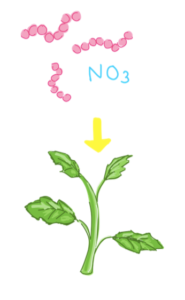Why Plants Need Nitrogen: Nitrogen Guide Part I
Many people don’t understand how or why fertilizers are created; the difference between various fertilizer formulas; or how fertilizers affect the natural world. In this first part of our two-part blog series, we’ll explain why plants need nitrogen, discuss the nitrogen cycle, and tune you in to how xVital is harnessing this nutrient in an innovative and ecofriendly way.
Why Plants Need Nitrogen
So you’re wondering why plants need nitrogen in the first place, huh? Well, to put it simply, nitrogen is absolutely essential for plants to grow. It is the building block of DNA, proteins, ATP, and other vital macromolecules. While we are able to obtain nitrogen simply by eating food, plants obviously cannot do the same thing.
Plants are able to use light energy to fix carbon from the air into a usable form through the process known as photosynthesis. But this phenomenon cannot be replicated with nitrogen.
Nitrogen found in the air exists in the form N2. In other words, the gas exists as two nitrogen atoms linked together by a very sturdy triple bond. Plants cannot use nitrogen directly from the atmosphere; rather, it must be “fixed” into a usable form. Fixed forms of nitrogen include ammonium (NH4), ammonia (NH3), and nitrate (NO3).
In order to acquire a fixed form of nitrogen, the triple bond mentioned previously must be broken. However, due to the sheer strength of the bond, plants are unable to break it alone and require some help.
Nitrogen Fixation
The following are two ways nitrogen is fixed in the natural world:
- Lightning:
When lightning strikes the ground, a tremendous amount of energy is released. This energy can drive a reaction between water and atmospheric nitrogen (N2) to create nitrate, which is a usable form of nitrogen.
Through extensive research and trial, xVirity has developed a probe, which can replicate this natural occurrence. The end result is a liquid fertilizer solution consisting only of nitrate ions and water, lacking the harsh chemicals that are typically present in commercial fertilizer.
- Bacteria:
Bacteria are responsible for a majority of nitrogen fixation. First, nitrogen-fixing bacteria perform an ammonification reaction, transforming atmospheric nitrogen (N2) to ammonium (NH4). After this, nitrifying bacteria nitrify ammonium, ultimately creating nitrate (NO3), which is the best form of nitrogen for plants (See Figure 1).
Note that this is a multi-step process that relies heavily on the viability and number of nitrogen-fixing and nitrifying bacteria. A lack of either of the two will result in less fixed nitrogen and ultimately less plant growth.


Figure 1: Transformation of gaseous nitrogen to ammonium and ultimately nitrate via bacteria
Why does the World Need xVital?
In our world of 7.5 billion people, lighting and bacteria simply are not enough to fix the amount of nitrogen required to grow crops that feed our ever-expanding population. Nitrogen is considered a limiting nutrient, meaning that it is of the shortest supply compared to other nutrients. Therefore, when more nitrogen is introduced into the soil, a significant impact on plant growth is observed. This is the very reason nitrogen-based chemical fertilizers were invented in the first place.
So now you know why plants need nitrogen! Stay tuned for Part II of this blog series, which will unearth the history of nitrogen fertilizer and explain why it is better for plants than ammonium fertilizer.



